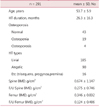Abstract
Objectives
We investigated the relationship between bone mineral density (BMD) and hormone therapy (HT) and its duration in postmenopausal women.
Methods
We performed a retrospective study on 291 postmenopausal women who had their BMD and follow-up BMD measured in a university hospital. We analyzed BMD, HT types and HT duration according to clinical characteristics.
References
1. Lee JK, Kim EJ, Suk MH, Kim EY, Hwang LI. Factors influencing osteoporosis. J Korean Community Nurs. 2003; 14:253–262.
2. Hall JW 3rd, Kennedy BJ. Idiopathic osteoporosis. Arch Intern Med. 1961; 108:448–455.
3. Kanis JA. WHO Study Group. Assessment of fracture risk and its application to screening for postmenopausal osteoporosis: synopsis of a WHO report. Osteoporos Int. 1994; 4:368–381.
4. National Institutes of Health. Osteoporosis. Conn Med. 1984; 48:651–655.
5. Wang XD, Masilamani NS, Mabrey JD, Alder ME, Agrawal CM. Changes in the fracture toughness of bone may not be reflected in its mineral density, porosity, and tensile properties. Bone. 1998; 23:67–72.
6. Anderson JJ. The role of nutrition in the functioning of skeletal tissue. Nutr Rev. 1992; 50:388–394.
7. Kim TH, Lee HH, Chung SH, Park HS. Differentiation in the management of osteoporosis between premenopausal and menopausal women. J Korean Soc Menopause. 2011; 17:21–26.
8. Kim JG, No JH, Hong JS, Kim SH, Choi YM, Moon SY, et al. A study on risk factors for postmenopausal osteoporosis. Korean J Obstet Gynecol. 2001; 44:1621–1626.
9. Park HM, So JS. The validational study of OSTA (Osteoporosis Self Assessment Tool for Asian) for prediction of osteoporosis in Korean post- and perimenopausal women. Korean J Obstet Gynecol. 2003; 46:276–282.
10. Cho SH, Cho SH, Kim KT, Hwang YY, Lee JA, Cho SS. Variations in spinal bone mineral density after one year of hormone replacement therapy in postmenopausal women. Korean J Obstet Gynecol. 1994; 37:1584–1590.
11. Kim JG, Ku SY, Jee BC, Suh CS, Kim SH, Choi YM, et al. The relationship between osteoprotegerin (OPG)-receptor activator of NF-kB ligand (RANKL) gene polymorphisms and change in bone mineral density after hormone therapy in postmenopausal Korean women. Korean J Obstet Gynecol. 2007; 50:901–911.
12. Chung YS. The medical treatment of osteoporosis. Korean J Med. 2010; 79:250–253.




 PDF
PDF ePub
ePub Citation
Citation Print
Print





 XML Download
XML Download